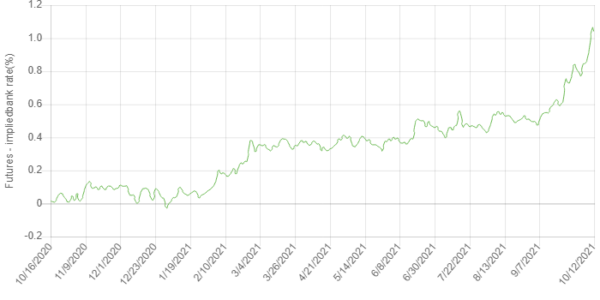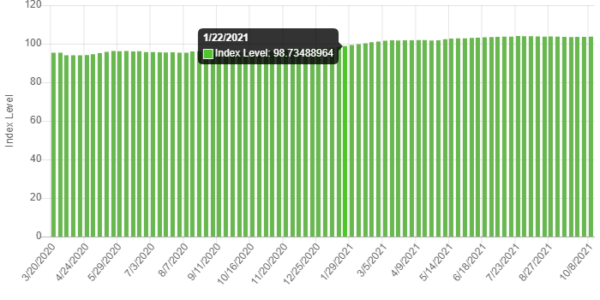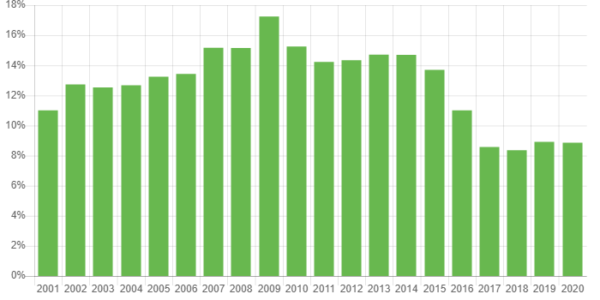Oct
2021
Global Perspectives: Remaining cautious as risks surface
DIY Investor
16 October 2021
 We remain cautious on global equities and underweight bonds. The risks which we highlighted last month are now surfacing. Investors are still being challenged to reconcile high equity valuations with slowing growth, tighter monetary policy and upcoming fiscal drag.
We remain cautious on global equities and underweight bonds. The risks which we highlighted last month are now surfacing. Investors are still being challenged to reconcile high equity valuations with slowing growth, tighter monetary policy and upcoming fiscal drag.
Rising energy prices and natural gas shortages appear to be only in part due to recovering demand. A collapse in global energy investment dating back to 2015, as institutional investors stepped away from backing fossil fuel-based infrastructure suggests that energy prices may remain high for some time, crimping consumer demand.
Markets are lower, but only by a little
Global equities have retreated somewhat from peak levels recorded during since early September but the declines in most sectors have been modest. No global sector has declined by more than 10%. Banks and energy have outperformed as interest rates have risen and investors discount a longer period of high oil and gas prices.
Exhibit 1: Global sector performance: Percentage declines still in single digits

Despite this ebbing of positive sentiment, equity valuations are still stretched and will in our view become increasingly relevant as economic momentum slows and monetary policy is steadily tightened. We were ready to downplay valuations earlier in the COVID-cycle as incredibly strong earnings momentum was always likely to be the dominant factor for short-term equity returns. Now, as growth slows and interest rates are on a tightening trajectory, valuations are likely to come under closer scrutiny. in our view. We note that in recent weeks upward revisions to earnings estimates have stalled.
Interest rates are higher, by a lot
There are now three phases evident in the post-COVID recovery in interest rate futures markets in both the US and UK. Initially, markets expected near-zero interest rates throughout 2022. The advent of vaccines shifted this to expecting a 50bps increase by the end of 2022 and this market pricing persisted until the beginning of September. However, in recent weeks market expectations for end-22 interest rates have doubled to over 1%.
Exhibit 2: UK futures markets now discounting higher BoE rates in 2022

Positive economic and profits momentum fading
We can see in survey data and in consensus earnings forecasts that momentum has faded during Q321 and it is not immediately clear which policy levers could be pulled to reverse this trend. The narrowing of output gaps gives good reason to believe that developed market economic growth from this juncture is likely to be significantly slower than in the prior three quarters as fiscal deficits are reduced and central banks turn their attention to maintaining their inflation fighting credentials.
Exhibit 3: Global consensus earnings revisions upgrade cycle has stalled

High energy prices may take time to return to normal
While at least some of the strength of energy markets can be attributed to the sheer rapidity of the post-COVID recovery we note that there has been a collapse in capital expenditure as a percent of total assets at the largest public oil companies on a global basis. Since the energy price collapse of 2016, capex has fallen to 8% of total assets compared to 14% beforehand. The ESG investment theme has created a clamouring for diverting cashflows to shareholders or green energy investments, rather than maintaining infrastructure and extending reserves which may later prove to be stranded assets.
Exhibit 4: Global energy sector capex as a percentage of total assets

As a supply-side factor, the consequence of this long period of lower investment is an increased risk that higher energy prices will persist for longer than investors expect. Higher prices for products of the petrochemical industry – from plastics and construction materials to CO2 and fertiliser – could send price increases ricocheting through global goods supply chains.
Remaining cautious on global equities
Bond markets and interest rate futures are only starting to discount the recent rise in inflation which was previously only evident in sharply higher consumer surveys on future inflation. It has been many years since central banks have had to contend with both undesirably high inflation and increasing inflation uncertainty and therefore for at least some investors this may be a novel development. The challenging combination of still-high asset prices, tightening monetary policy and fiscal drag as markets look towards 2022 keeps us cautious on the outlook for global equities at this time.

Brokers Commentary » Brokers Latest » Commentary » Equities » Equities Commentary » Equities Latest » Latest
Leave a Reply
You must be logged in to post a comment.